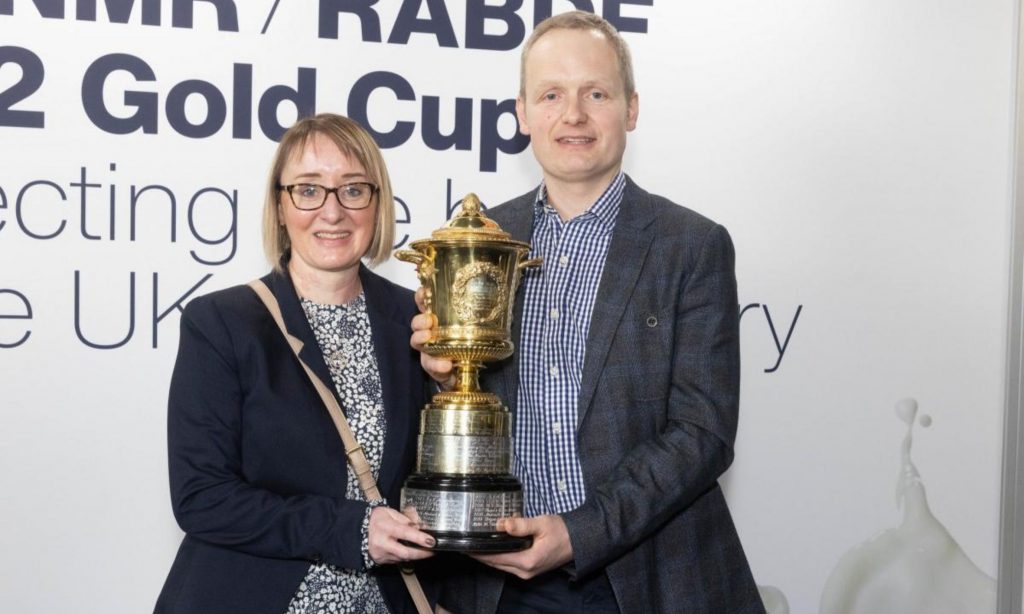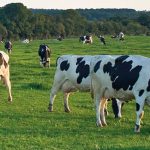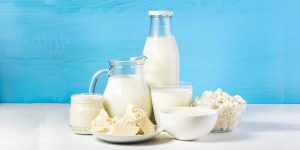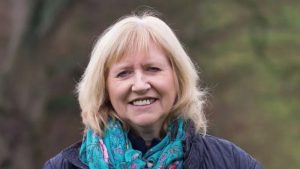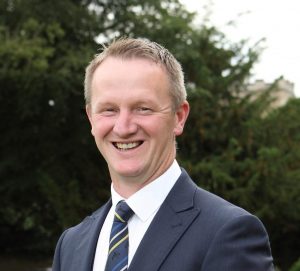
The award which was presented at the Stoneleigh-based event, saw the chairman of the Royal Association of British Dairy Farmers, Di Wastenage, present the Gold Cup to Alistair and Anne Logan of the Holehouse Holstein herd from Ayrshire.
Ms Wastenage, who was one of the award judges, viewed the Logan’s as ‘having it all’ when it comes to a farming system.
“They tick all the boxes for sustainability, the environment, maximising output from the land, and optimising herd health and welfare,” she said. “They’re at the forefront of many technological advances to help drive forward their 280-cow pedigree Holstein herd.”
Now in its fifth generation, the Logan partnership consists of brothers Alex, Tom and Hugh, alongside Tom’s sons Alistair and Stuart, who run 280 mainly red and white pedigree Holstein cows. The cows averaged 10,500kg at 4.10% butterfat and 3.40% protein on twice a day milking for the qualifying year to September 2021 with milk from this all-year-round calving herd sold to Muller.
The use of technology and data to maximise cow health and welfare, and the application of renewable energy are key factors that the Logans consider will help them progress and future-proof their business.
Four other awards were made as part of the Gold Cup presentations, all to herds that qualified for the competition.
The NMR Silver Salver for the Holstein herd with the highest combined weight of fat and protein production went to The Scottish Farmer’s Field Margins’ columist John Harvey, who together with his brother Stuart, and their mother Margaret, manage a herd of 300 pedigree Holstein cows at Drum Farm in Dumfries.
No stranger the limelight, their Killywhan herd has won many awards, including Scottish Dairy Farm of the Year. They have also been finalists in the Gold Cup on several occasions.
Three years ago, in 2020, the Stuarts won the Chris May Memorial Award, and this year, they collect the Silver Salver among Holstein herds, having achieved a combined fat and protein yield of 1017kg per cow and 14,267kg of milk on three-times-a-day milking regime.
The main breeding focus here is keeping size down, after that they are mainly interested in increasing protein. The Harveys are on a cheese contract and as such get additional bonuses for achieving good levels of protein in the milk.
The cows’ diet supports production of solids with a mineral pack which includes additional methionine to support milk protein production.
The Lilyhill Cup for the Jersey herd with the highest combined weight of fat and protein went to Lanarkshire breeders, Robert, Lorraine and Mark Hunter, of the Clydevalley herd from West Tarbrax.
Their all-Jersey unit consists of 160 milking cows supplying milk to Graham’s Dairy. Controlling the cows’ diet is the secret to their herd’s high fat and protein levels which saw a combined weight of 878.42kg per cow.
Cows are buffer fed at night throughout the year, even though they are outside grazing from early spring through to autumn, with the stability in the overall diet resulting in top milk quality.
Cows are fed high quality round bale silage. The Hunters harvest grass at the optimum time and aim for dry matters of 35% to 40%. Cows are also fed an 18% protein cake in the parlour and a 16% blend, mixed with the silage, in a tub mixer when housed.
Sexed semen from Canadian and American bulls is used across the herd’s top 60-70% of animals, with the rest AI’d to Aberdeen-Angus sires. Longevity plays a key part when selecting bulls, with breeding decisions very much type-orientated.
Cows are yielding 8063kg of milk at 6.97%BF and 3.93%P. Such is the longevity of the herd, that the Hunters are able to sell 50 cows and heifers per year.
The Chairman’s Cup for breeds, except Holstein and Jersey, with the highest combined weight of fat and protein went to Richard Bell, Nerewater, Wigton.
Mr Bell, a second generation Cumbrian dairy farmer runs his all-year-round calving pedigree Friesian herd of 70 milking cows almost single-handedly on a grass-based system. Cows graze outside from the end of April through to October, with homegrown feed the mainstay of the cows’ diet.
Five to seven hectares of spring and winter barley are grown and harvested as wholegrain and straw. Barley is fed to youngstock and cows, and the straw is used as bedding. Concentrates are fed in the parlour.
Growing cereals not only helps keep feed costs low but also aids the grass rotation, with leys reseeded with high-sugar grass varieties and clovers every eight years.
Selling surplus stock provides an added income for this business, with up to 23 breeding bulls sold a year along with surplus dairy cows, heifers and youngstock.
The herd is currently averaging 8800kg of milk with a 4.40%BF and 3.52%P, which coupled with a combined weight of 738kg milk solids, put the herd in top place.
Essex-based producer, John Torrance, Stapleford Abbotts and former Gold Cup winner, won The Chris May Memorial Award for the highest average lifetime daily yield.
His Curtismill pedigree Holstein herd, comprising 670 cows and 430 followers, achieved an average lifetime daily yield of 22.30kg of milk per cow per day.
This dairy business, run by John Torrance in partnership with father Robert, mother Janet and wife Lucy, was winner of the Gold Cup 2020.
Other finalists for the Gold Cup included Stuart Orr from Kaemuir Farm, Avonbridge, Scotland
This family-run unit, consisting of son Stuart, his parents George and Marion and brother Scott, is run as a tight ship. The 260 cows average 10,258kg at 3.98% butterfat and 3.25% protein on twice a day milking
Their calving interval is 368 days and age at first calving has been reduced by eight months to 22 months in the past 11 years. Health is a high priority and the annual average cases of mastitis is just 8%.
They aim to breed a long-lived and well-balanced cow and began genomically testing all newborn calves and heifers under one at the start of 2022.
The other three Gold Cup finalists were :
Liz Birkett, Rookhaye Farm, Bowerchalke, Salisbury, Wiltshire; Chris and Helen Ford, Peadon Farm, Fiddington, Bridgwater, Somerset and Andrew, Oliver and Wendy Reed, France Farm, Blackborough, Cullompton, Devon.
